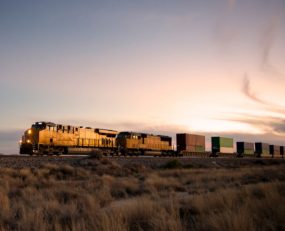
The US economy grew at an annualised rate of 3.0% in Q3. Following on from a similar performance in Q2, this represented its strongest six-month stint of growth for three years.
Consumer and business spending were key contributors. Durable goods (+8.3%) and equipment spending (+8.6%) were particularly strong.
These economic factors helped boost growth for the US overland freight transport market. As quarterly results were announced, CEOs were quick to praise their companies’ efforts and highlight positive metrics. In reality, reports of a stronger economy are very welcome, and are more impressive given that the period includes two devastating hurricanes.
For example, Kansas City Southern estimated that operating income fell by an estimated $19m-$23m in the quarter due to Hurricane Harvey. Nonetheless, it still achieved growth of 17.0%. This was down to higher revenue growth in all of its operating units.
Elsewhere, Hub Group, which purchased Estenson Logistics earlier in the year, posted its first $1bn revenue quarter. Landstar’s top line wasn’t far off this figure, reporting 20% growth in Q3 to turn over $943m. It was one of many companies to take a leap of faith in cross-border logistics, in spite of President Trump’s threats to NAFTA. It expanded its services in Mexico, aimed at improving cross-border capabilities at 11 service points.
Meanwhile rail operators Norfolk Southern and Canadian National had solid quarters. They agreed a deal to interchange trains outside one of the busiest rail hubs in North America, cutting transit times by up to 48 hours. The deal is significant, showing the ability of major players to co-operate to provide faster solutions for their customers.
Elsewhere, CSX, still going through re-structuring at boardroom level, only produced 1% revenue growth, but its volumes were up 5%. Despite complaints from major customers over its services, it is managing to remain fully competitive and improved operating profit by 4% in the quarter.
Company performances largely varied across product lines and vertical sectors. However, intermodal jumps out as a strong point across most major providers. Canadian National’s intermodal carloads were up 20% in the quarter and Norfolk Southern broke its own previous volume records.
In other developments, General Electric, one of the world’s largest freight locomotive producers, indicated it may leave the market. Its profits fell 15% in the first nine months of the year after suffering from slack demand.
Despite that gloomier note, Q3 was largely positive for overland transport providers. With increasing business and consumer confidence, and fundamentals looking strong, they have plenty of reasons to be optimistic.
Source: Transport Intelligence, October 31, 2017
Author: Andy Ralls